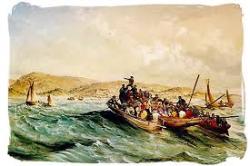
Published date
17 March 1820
After the Napoleonic wars, Britain experienced a serious unemployment problem. Therefore, encouraged by the British government to immigrate to the Cape colony, the first 1820 settlers arrived in Table Bay on board the Nautilus and the Chapman on 17 March 1820. From the Cape colony, the settlers were sent to Algoa Bay, known today as Port Elizabeth. Lord Somerset, the British governor in South Africa, encouraged the immigrants to settle in the frontier area of what is now the Eastern Cape. This was in order to consolidate and defend the eastern frontier against the neighbouring Xhosa people, and to provide a boost to the English-speaking population. This period saw one of the largest stages of British settlement in Africa, and approximately 4,000 Settlers arrived in the Cape, in around 60 different parties, between April and June 1820. The settlers were granted farms near the village of Bathurst, and supplied equipment and food against their deposits. A combination of factors caused many of the settlers to leave these farms for the surrounding towns. Firstly, many of the settlers were artisans with no interest in rural life, and lacked agricultural experience. In addition, life on the border was harsh and they suffered problems such as drought, rust conditions that affected crops, and a lack of transport. Therefore many settlers left the eastern border in search of a better life in towns such as Port Elizabeth, Grahamstown and East London. The eastern border therefore never became as densely populated as Somerset had hoped. The settlers who did remain as farmers made a significant contribution to agriculture, by planting maize, rye and barley. They also began wool farming which later became a very lucrative trade. Some of the settlers, who were traders by profession, also made a significant contribution to business and the economy. New towns such as Grahamstown and Port Elizabeth therefore grew rapidly. Another group of 1820 settlers continued on to Natal (KwaZulu Natal), the home of the Zulu people. At the time, King Shaka ruled the territory with highly-trained warriors. Leaders of the Natal settlers requested permission from Shaka to stay on the land, and when the king witnessed the settlers' technological advances, permission was granted in return for firearms. The 1820 settlers are commemorated in Grahamstown by the 1820 Settlers National Monument, which opened in 1974. A living monument, it hosts plays, musical performances and cultural events.
References
Wallis, F. (2000). Nuusdagboek: feite en fratse oor 1000 jaar, Kaapstad: Human & Rousseau Giliomee, H. and Mbenga, B. (2007).| New History of South Africa. Tafelberg Publishers, Cape Town, pg 85-87.